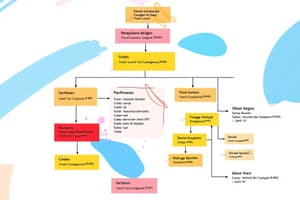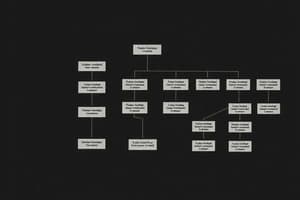Podcast
Questions and Answers
Which method emphasizes the use of diagrams and symbols for software documentation?
Which method emphasizes the use of diagrams and symbols for software documentation?
- Jacobson's Use Cases
- UML methods
- Object Modeling Technique
- Booch Method (correct)
Which approach focuses on modeling the system's behavior from the user's perspective?
Which approach focuses on modeling the system's behavior from the user's perspective?
- Object Modeling Technique
- Booch Method
- UML methods
- Jacobson's Use Cases (correct)
Which approach emphasizes the importance of understanding the workflow involved in system development?
Which approach emphasizes the importance of understanding the workflow involved in system development?
- Object Modeling Technique
- Jacobson's Use Cases
- Booch Method (correct)
- UML methods
Which approach emphasizes the use of analogies to understand the development process?
Which approach emphasizes the use of analogies to understand the development process?
What is the role of 'extends' in object-oriented development?
What is the role of 'extends' in object-oriented development?
What is the primary purpose of a Use Case Diagram in the context of software development?
What is the primary purpose of a Use Case Diagram in the context of software development?
Which of the following is NOT a characteristic of a Use Case Diagram?
Which of the following is NOT a characteristic of a Use Case Diagram?
What is the significance of actors in a Use Case Diagram?
What is the significance of actors in a Use Case Diagram?
What is the main purpose of the 'UML Class' in software development?
What is the main purpose of the 'UML Class' in software development?
What is the primary difference between a static and dynamic model in software development?
What is the primary difference between a static and dynamic model in software development?
Which of the following is NOT a type of diagram typically used in UML (Unified Modeling Language)?
Which of the following is NOT a type of diagram typically used in UML (Unified Modeling Language)?
What is the primary role of a 'Use Case Description' according to the provided content?
What is the primary role of a 'Use Case Description' according to the provided content?
Which of the following is NOT a primary activity present in object-oriented design?
Which of the following is NOT a primary activity present in object-oriented design?
What is the main purpose of class diagrams in object-oriented design?
What is the main purpose of class diagrams in object-oriented design?
Which of the following is an example of a method typically found in a "Bank Account" class?
Which of the following is an example of a method typically found in a "Bank Account" class?
When designing a system, when would you implement "protected" access modifier for methods?
When designing a system, when would you implement "protected" access modifier for methods?
What is the purpose of CASE tools in object-oriented design?
What is the purpose of CASE tools in object-oriented design?
What is the primary benefit of using packages in object-oriented design?
What is the primary benefit of using packages in object-oriented design?
Which of the following is NOT a key aspect of defining a class in object-oriented design?
Which of the following is NOT a key aspect of defining a class in object-oriented design?
Which of the following accurately describes the difference between an "activity diagram" and a "use case diagram"?
Which of the following accurately describes the difference between an "activity diagram" and a "use case diagram"?
How can a "Shopping ATM system" be modeled as a package in object-oriented design?
How can a "Shopping ATM system" be modeled as a package in object-oriented design?
What is the primary focus of the 'Object Oriented Design' process?
What is the primary focus of the 'Object Oriented Design' process?
Which of the following best describes the relationship between 'Use Case Analysis' and 'Developing a UML class diagram'?
Which of the following best describes the relationship between 'Use Case Analysis' and 'Developing a UML class diagram'?
Which of the following is NOT a key component of the process of 'Object Oriented Design'?
Which of the following is NOT a key component of the process of 'Object Oriented Design'?
According to the provided context, which of the following is the primary goal of 'Design Axioms'?
According to the provided context, which of the following is the primary goal of 'Design Axioms'?
Identify the primary difference between 'Design Patterns' and 'Design Axioms'?
Identify the primary difference between 'Design Patterns' and 'Design Axioms'?
What is the main purpose of 'Design Axioms' in relation to 'Design Patterns'?
What is the main purpose of 'Design Axioms' in relation to 'Design Patterns'?
Identify the most suitable approach to understand the functionality expected in an 'ATM banking system' before developing detailed design elements.
Identify the most suitable approach to understand the functionality expected in an 'ATM banking system' before developing detailed design elements.
What is the correct order in which the following concepts are applied in the 'Object Oriented Design' process: (I) Design Patterns, (II) Design Axioms, (III) Use Case Analysis, (IV) UML Class Diagram?
What is the correct order in which the following concepts are applied in the 'Object Oriented Design' process: (I) Design Patterns, (II) Design Axioms, (III) Use Case Analysis, (IV) UML Class Diagram?
Which of the following accurately explains the relationship between 'Design Axioms' and 'Design Patterns'?
Which of the following accurately explains the relationship between 'Design Axioms' and 'Design Patterns'?
Flashcards
Object-Oriented Development
Object-Oriented Development
A programming paradigm based on the concept of objects, which contain data and methods.
Phases in OO Development
Phases in OO Development
The stages of the object-oriented development process, usually including analysis, design, implementation, testing, and maintenance.
Rambaugh Method
Rambaugh Method
A methodology for object-oriented analysis and design developed by Grady Booch, James Rambaugh, and Ivar Jacobson.
Use Case
Use Case
Signup and view all the flashcards
Booch Method
Booch Method
Signup and view all the flashcards
Software Development Process
Software Development Process
Signup and view all the flashcards
Use Case Diagram
Use Case Diagram
Signup and view all the flashcards
Actors in Use Case
Actors in Use Case
Signup and view all the flashcards
UML (Unified Modeling Language)
UML (Unified Modeling Language)
Signup and view all the flashcards
Class Diagram
Class Diagram
Signup and view all the flashcards
Association in Class Diagram
Association in Class Diagram
Signup and view all the flashcards
Use Case Descriptions
Use Case Descriptions
Signup and view all the flashcards
UML Class Diagram
UML Class Diagram
Signup and view all the flashcards
Use Case Analysis
Use Case Analysis
Signup and view all the flashcards
Cohesion
Cohesion
Signup and view all the flashcards
Coupling
Coupling
Signup and view all the flashcards
Design Axiom
Design Axiom
Signup and view all the flashcards
Design Patterns
Design Patterns
Signup and view all the flashcards
Responsibilities in classes
Responsibilities in classes
Signup and view all the flashcards
Independent components
Independent components
Signup and view all the flashcards
Motivation in Design
Motivation in Design
Signup and view all the flashcards
Object-Oriented Analysis
Object-Oriented Analysis
Signup and view all the flashcards
Design Classes
Design Classes
Signup and view all the flashcards
Attribute Types
Attribute Types
Signup and view all the flashcards
Public Method
Public Method
Signup and view all the flashcards
Private Method
Private Method
Signup and view all the flashcards
Protected Method
Protected Method
Signup and view all the flashcards
Activity Diagram
Activity Diagram
Signup and view all the flashcards
CASE Tools
CASE Tools
Signup and view all the flashcards
Study Notes
Object Oriented Analysis and Design Lesson Plan
- Course Objectives:
- Learn the concept of Object Oriented Software Development
- Understand UML Diagrams
- Understand Object Oriented Analysis processes
Unit 1: Object Oriented Methodologies
- Introduction:
- Brief introduction to object-oriented analysis and design
- System Life Cycle & Traditional Life Cycle Models:
- Overview of frameworks and activities involved in development systems versus traditional life cycles
- Comparison and contrast of different life cycle models
- Discussion of orthogonal views of software
- Discussion of UML methods used
- Object-Oriented Approach:
- Understanding the phases involved in object-oriented approaches
- Booch Methodology:
- Booch method to document systems with symbols
Unit 2: UML Diagrams
- Introduction:
- Brief overview of different types of UML diagrams
- Discussion of static and underlying models
- Use Case Diagram:
- Definition of use case diagram
- Explanation of use case concepts
- UML Class Diagram:
- Definition of UML class diagram
- Graphical representation of use case diagrams
- User descriptions for ordering books
Unit 3: Object Oriented Analysis
- Introduction:
- Understanding objects, attributes, and design process
- Object Approaches:
- Defining object attributes
- Discussion of object-oriented approaches for classes and behaviors
- Guidelines for identifying objects and associations
- Methods for Developing UML Diagram:
- Developing UML class diagrams based on use case analysis
Unit 4: Object Oriented Design
- View Layer Design:
- Responsibility for input and output of applications
- Macro and micro level UI design
- Micro and Macro Level Process:
- Analyzing use case in micro and macro level
- Designing ATM systems
- Prototyping User Interface:
- Rapid prototyping and incremental development approaches for user interface design
- Case Study:
- Designing user interface for bank ATM systems
- Creating access classes for bank client classes
Unit 5: Design Patterns
- Design Patterns Introduction:
- Different types of design patterns- structured and creational patterns
- Selecting a design pattern for design problems
- Design Patterns in Practice:
- Implementation through pattern usage
- Structural, behavioral, creational pattern examples
Studying That Suits You
Use AI to generate personalized quizzes and flashcards to suit your learning preferences.




